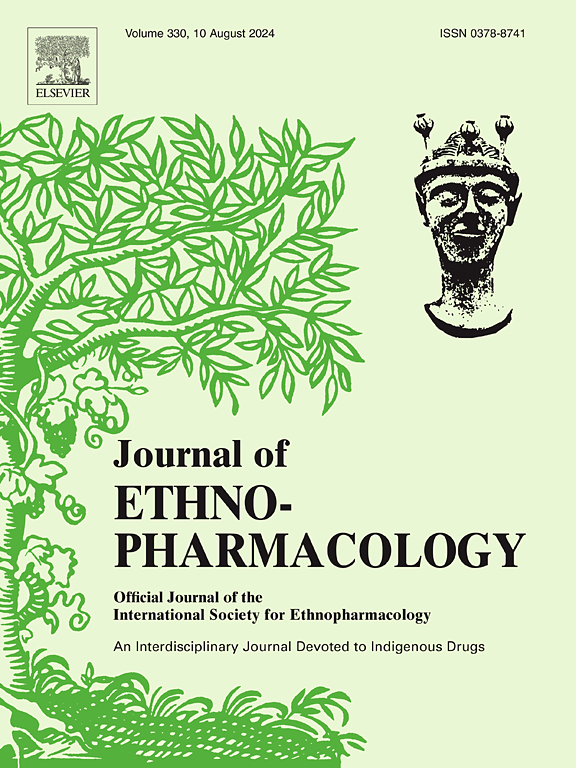福斯克无花果醇提物在白化大鼠体内的抗疟活性和脂质谱
IF 4.8
2区 医学
Q1 CHEMISTRY, MEDICINAL
引用次数: 0
摘要
研究目的由于医疗保健服务有限,耐药疟疾在撒哈拉以南非洲是一个重大问题。本研究利用小鼠模型研究了榕叶提取物的治疗和抗疟作用。材料与方法选用体重150 ~ 200 g的wistar系雄性白化大鼠30只,随机分为15组,每组6只。1组为对照组,2 ~ 5组腹腔注射1 × 101伯氏疟原虫(NK 65株)感染红细胞0.2 ml;对照组2不接受任何治疗。从第4天到第8天,将提取液以不同剂量给药给3、4、5组:高剂量组400 mg/kg b.w.,中剂量组200 mg/kg b.w.,氯喹组10 mg/kg b.w.。在第0、4和8天分别从动物的下颌下区域采集血液,评估寄生虫血症和血脂。结果在第4天,所有治疗组均表现出与阳性对照(PC)相似的寄生虫血症水平,且显著升高(p <;0.001)。到第8天,P.C.组的寄生虫率最高(48.74±0.42%),而高剂量提取物(HDE)、低剂量提取物(LDE)和标准对照(SC)显著降低了寄生虫率(p <;0.001)。SC组抑制率最高(83.17±0.65%),对降低寄生虫率最有效。而在脂质分析结果中,HDE和LDE有效地恢复了低密度脂蛋白(LDL)和总胆固醇(T. Chol)水平,其中HDE更有效,而SC组维持了接近正常值。高密度脂蛋白(HDL)水平虽未达到阴性对照(NC)值,但经HDE和LDE治疗后明显改善,SC水平接近正常。甘油三酯(Trig.)水平在所有组中保持一致,没有显著差异。结论无花果提取物具有良好的抗疟作用,可作为治疗疟疾的一种潜在替代药物。本文章由计算机程序翻译,如有差异,请以英文原文为准。

Antimalarial activities and lipid profile of ethanolic extract of Ficus sur Forssk (described by Peter Forsskål) in Plasmodium berghei infected albino rats
Aim of the study
Drug-resistant malaria is a significant issue in sub-Saharan Africa due to the limited availability of healthcare. This study examined the curative and antimalarial properties of Ficus sur leaf extract using a mouse model.
Materials and methods
Thirty (30) male albino rats of the wistar strain, with weights spanning from 150 to 200 g, were divided into fifteen groups, each consisting of six rats. Group 1, which served as the control, administered 0.2 ml of 1 × 101 Plasmodium berghei (NK 65 strain) infected erythrocytes intraperitoneally to Groups 2 to 5. Parasite control group 2 did not receive any treatment. From day 4 to day 8, the extract was administered to groups 3, 4, and 5 at varying doses: 400 mg/kg b.w. for the high dosage, 200 mg/kg b.w. for the moderate dose, and 10 mg/kg b.w. for chloroquine, respectively. Blood samples were collected from the submandibular region of the animals on days 0, 4, and 8 to evaluate parasitemia and lipid profile.
Results
The findings from this study indicate that by day 4, all treated groups showed similar parasitemia levels to the positive control (PC), with a significant increase (p < 0.001). By day 8, parasitemia was highest in the P.C. group (48.74 ± 0.42 %), while high dose extract (HDE), low dose extract (LDE), and standard control (SC) significantly reduced parasitemia (p < 0.001). The SC group demonstrated the highest inhibition (83.17 ± 0.65 %), proving the most effective in reducing parasitemia. While in lipid profile result, HDE and LDE effectively restored low density lipoprotein (LDL) and total cholesterol (T. Chol) levels, with HDE being more effective, while the SC group maintained near-normal values. High density lipoprotein (HDL) levels were significantly improved by HDE and LDE, though not reaching negative control (NC) values, while SC showed near-normal levels. Triglyceride (Trig.) levels remained consistent across all groups with no significant differences.
Conclusion
The findings indicate that Ficus sur fractions possess promising antimalarial properties and could be explored as a potential alternative therapy for malaria treatment.
求助全文
通过发布文献求助,成功后即可免费获取论文全文。
去求助
来源期刊

Journal of ethnopharmacology
医学-全科医学与补充医学
CiteScore
10.30
自引率
5.60%
发文量
967
审稿时长
77 days
期刊介绍:
The Journal of Ethnopharmacology is dedicated to the exchange of information and understandings about people''s use of plants, fungi, animals, microorganisms and minerals and their biological and pharmacological effects based on the principles established through international conventions. Early people confronted with illness and disease, discovered a wealth of useful therapeutic agents in the plant and animal kingdoms. The empirical knowledge of these medicinal substances and their toxic potential was passed on by oral tradition and sometimes recorded in herbals and other texts on materia medica. Many valuable drugs of today (e.g., atropine, ephedrine, tubocurarine, digoxin, reserpine) came into use through the study of indigenous remedies. Chemists continue to use plant-derived drugs (e.g., morphine, taxol, physostigmine, quinidine, emetine) as prototypes in their attempts to develop more effective and less toxic medicinals.
 求助内容:
求助内容: 应助结果提醒方式:
应助结果提醒方式:


